#astra militarum lore
Text

The Omnissiah’s own blessed caliber, .45, as passed down to archmagos John Moses Browning in mid 904.M2, and first used in stub guns in 907.M2.
The blessed and holy "Terran" pattern stub gun was first made in the polity now known as the United Hives of Merica in the year 911.M2, and reached its peak form in 924.M2.
It has been in the armories of humanity continuously since then, with various forges offering slightly varying patterns with numerous changes - the "Browning schism" is a historical argument over the proper caliber for such a stub gun, which has been observed in historical records as far back as the last 50 years of M2.

Archmagos Browning is also known for creating the standard "Terran" pattern of heavy stubber still in use on new Space Marine vehicles and Imperial Knights, with its blessed .50 Browning caliber (named directly for said Archmagos), which has been in service since 921.M2, and in its current form since 0.788.010.M3.
Many examples of the weapon have been found with curious, crude engravings. Translations of some of these engravings have yielded alphanumeric strings (most in ancient, near-dead, or extinct tongues) such as OMAHA B. ‘44, K. SAHN ‘68, BAGHDAD '03, банмут ‘22, ANTARC '42, PANDORA 2170, and many more. Techpriests still debate whether these designate previous wielders of the weapon(s) or are perhaps some early, crude form of purity markings.
EDIT: heretekical errors corrected in following update data-pulse:
134 notes
·
View notes
Text



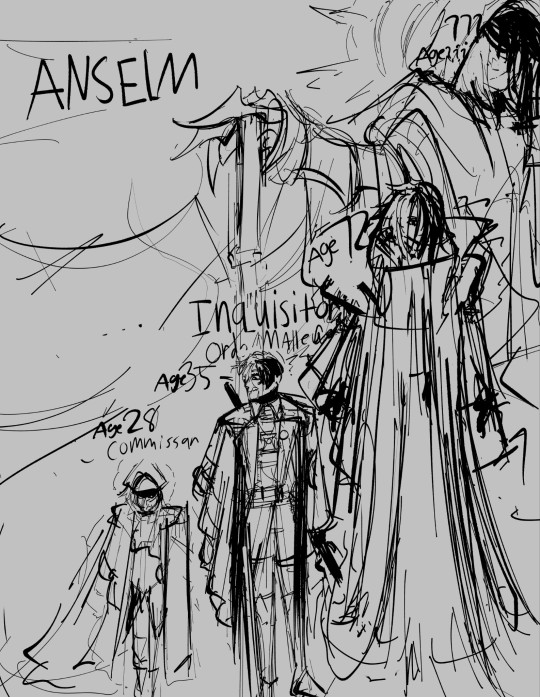
Basically, Anselm Caim has the whole nine yards of "cringe" lore because i am very much sick and tired of being stick-up-my-ass lore compliant with 40k and I wanted to make what I want: Xianxia Cultivation in the Grim Darkness of the Far Future in the 42nd Millenium... or 41st... don't care.
#warhammer 40k#wh 40k#original character#my art#sister of battle#psyker#adepta sororitas#astra militarum#imperial guard#imperium of man#inquisitor#it is 2024 and im#tired of being lore compliant#i will be cringe with my ocs
8 notes
·
View notes
Text

Summary
Lieutenant Mahin and Commissar Rembault of the 1012th Cadian regiment, are fighting the treacherous xenos called the T'au on the world of Kupa V. After annihilating a platoon of human collaborators, and shooting the survivors, one of them is somehow still alive. Sergeant First Class Rokken "Rokk" Tamaguchi. Who is this strange human soldier? What is his story? And why is he now fighting for the T'au Empire?
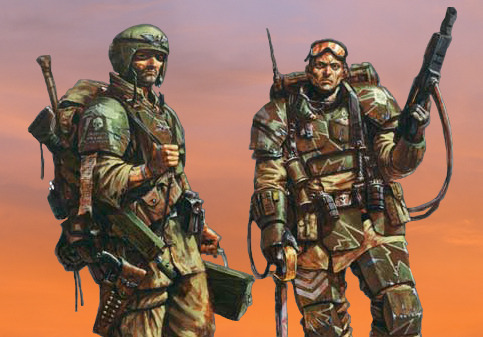
Artwork:
1) Imperial Guard Sketch by Salvador Trakal
2) Cadians Karl Kopinski, Games Workshop
Excerpt
‘I’ll ask again, what’s your name?’ said the Commissar lighting the tabac stick for herself.
‘Sergeant First Class Rokken A. Tamaguchi. Ident number 456-789-22010,’ he replied, looking at the commissar with his one good eye, the other having been glued shut, by dried blood.
‘Unit sergeant?’
The prisoner took in a breath, coughed, and grunted out, ‘2nd Platoon, Bravo Company, 1st Battalion, of the 7th Mu’gulath Bay Regiment.’
‘I guess it takes a commissar to get these traitors to talk, uh ma’am?’ said the sergeant.
The prisoner turned and glared up at the sergeant with his one good eye.
‘Got a problem, heretic? Want a boot up your arse?’ shouted Demin getting ready to kick the prisoner.
‘Hold on, sergeant!’ shouted the commissar with the tabac stick still between her teeth. Getting up, she shooed away the small crowd of guardsmen who were gathered around the prisoner. Then, pulling the sergeant aside, she asked, ‘So, Sergeant, tell me What-the-Throne is going on here?’
The sergeant straightened his back and looking off into the desert said, ‘There was a firefight. We over ran their position. Shot all the survivors, including the wounded. Then two hours later this heretic here…’ Demin pointed at the prisoner. ‘…Comes staggering out of the pile of dead bodies holding his head in his hands. He’s gibber jabbering away in that Blue-fish talk, “Tiki-tak ching-chang-chong oola-la-la!” So we gave him a rifle butt to the stomach, bound his hands, and sat his traitorous backside on the ground.’
‘Did you interrogate him?’
‘We tried. But he just wouldn’t answer. So we gave up, figuring he didn’t speak any Low Gothic.’
#once a cadian always a cadian#wh40k lore fiction#games workhop#cadians#imperial guard#astra militarum#wh40k t'au empire#gue'vesa#sergeant rokk tamaguchi#fighting for the greater good#we got puppies#n.y.a.b.x.t.t.
27 notes
·
View notes
Text

Little bit of mail showed up today.
This is one of the last old school lore books I had yet to own till now.
#warhammer 40k#warhammer#oldhammer#the battle for armageddon#armageddon#steel legion#orcs#imperial guard#astra militarum#book#lore#history
9 notes
·
View notes
Text


Objective marker/decorative terrain piece is donezo
#Warhammer#warhammer 40k#warhammer 40000#Warhammer Lore#WH40K#death korps of krieg#Krieg#astra militarum#Imperial Guard#kill team#miniature#miniature painting#kitbash
103 notes
·
View notes
Text
Frozen Bloods: The Iron Wolves of Catera
In the grim darkness of the 41st Millennium, where hope flickers like a guttering candle in a blizzard, the Cateran Iron Wolves stand as a monument to the resilience of the human spirit, and an exemplar of the ceaseless will to fight, never surrendering, and laughing in the face of oncoming doom. Hailing from the frozen fortress world of Catera, these men and women are forged from the same unforgiving snow and stone as their desolate home, their hearts burning with the unyielding fire of Imperial loyalty. Their motto, whispered in the echoing tunnels beneath their icy carapace, rings true: "Where the sun dies, the Wolf shall rise."
Catera, their cradle and crucible, lies under a dying sun, its surface an expanse of eternal twilight where temperatures plummet far below the bite of frost in the pale light that barely warms the frozen plains. To survive, the Caterans burrowed deep, carving an intricate tapestry of subterranean dwellings within the planet's icy heart. These cities, monuments to their defiance, pulse with life, each a labyrinthine fortress built upon generations of toil and hardship. Here, amidst the lamplight and rhythmic hum of geothermal generators, thrives a society forged in sweat and steel.
Military service is the way and weft of Cateran life. Every Cateran child, at the tender age of fifteen, is plunged into the icy embrace of the "27 Hammers", a basic training regime lasting 27 body-breaking and will-shattering weeks. This brutal military training, a crucible of discipline and tactics, transforms them into the bedrock of the formidable Cateran Planetary Defense Force. Here, they learn the art of fortification, the grim dance of trench warfare, and the unyielding spirit of siegecraft. Every sandbag, every barbed wire entanglement, is a testament to the Cateran philosophy: turn every battlefield into an unbreachable fortress, a meat grinder that chews up invaders and spits out only dust and ghosts. It is from this pool of unwavering duty that the Imperial Guard draws Catera's greatest strength: the various regiments, legions, and armies that are collectively known as the Iron Wolves.
The influence of the Imperial Fists, who claimed Catera during the Great Crusade, runs deep. Cateran soldiers, their veins coursing with the icy spirit of their homeworld, bear the legacy of Rogal Dorn, the First Fist himself. His campaigns, especially the legendary defense of Terra, are their scripture, studied like hymns and whispered around crackling hearths. Each Iron Wolf officer carries the weight of Dorn's memory, his tactics and strategems etched into their souls.
Though masters of fortification and siege warfare (on both sides of the siege), the Iron Wolves are not chained to Catera's frigid grasp. The Astra Militarum recognizes their unique skills, deploying them across the galaxy whenever a world needs shoring up, a difficult defense cracked open, or a strategic chokepoint held with ironclad tenacity. From the sun-scorched plains of Armageddon to the blasted moons of Agrellan, the Iron Wolves bring their brand of unyielding and resolute warfare to every battlefield.
Yet despite their deathly homeworld and harsh military culture, the Iron Wolves are not mere stoic automata. Beneath their frozen exteriors beats a heart warm with jovial camaraderie and good humor. They crack jokes in the face of oblivion, forge bonds of brotherhood in the frozen mud, and share stories of home and hearth around flickering campfires. Their laughter, echoing through the trenches and tunnels on countless battlefields on countless worlds, is a defiant challenge to the encroaching darkness, a reminder that even in the bleakest of times, the human spirit can find solace in shared hardship, a steaming pot of recaf, and a well-told joke.
This warmth, however, is not a weakness. In fact, it is the fuel that drives their unwavering loyalty, the oil that keeps the gears of their discipline turning. When the order comes to hold the line, the Iron Wolves do so with the icy resolve of their homeworld, their smiles masking an unyielding determination. They fight not just for Catera and the Emperor, but for each other, for the laughter shared in the trenches, and for the stories whispered in the dark. Amongst the ice and iron, they nurture a spirit of defiance that burns far brighter than their failing sun.
Indeed, such is the Cateran reputation for unflinching good humor that a sour disposition amongst the Iron Wolves is not a mere frown, it is a harbinger of imminent doom. Such a thing whispers of losses so staggering, of challenges so dire, that even their legendary humor cannot pierce the suffocating veil of despair. But even then, even in the abyss, there remains a flicker of hope. For the Cateran spirit, like the fire within their mountain-carved homes, refuses to be extinguished.
The Caterans have carved a reputation for themselves as a force who accomplishes even the improbable, and adapts their approach quickly and organically. Though victors of thousands of battles since the Horus Heresy, a handful have become well known even in the greater Astra Militarum.
Seyb, a volcanic moon of a gas giant, was a haven for feral Orks. When Waaagh! Groggnot descended upon the planet, the Planetary Defense, outmatched, called for reinforcements. The 121st Cateran Iron Wolves, veterans of a dozen campaigns, landed in the teeth of the green tide. Trenches were quickly dug in the volcanic ash, and bunkers were reforged from mining outposts. The field (dubbed "No-Orksland" by the soldiers) turned into a maelstrom of scrap and Ork bodies, while the ground trembled and shook with heavy bolters, artillery, and the detonations of munitions set by subterranean sappers. The Iron Wolves turned their position into a labyrinth that froze the Greenskin assault in its tracks. Every Ork charge met a hail of lasfire, every open stretch of land became a killing field. For six long months, the blizzard of ork bodies slammed against the Cateran ramparts, and for six long months, the Iron Wolves held. When Warchief Groggnot fell, his Waaagh! splintered like fractured ice, leaving Seyb littered with green corpses and the satisfaction of the 121st.
On Antoniades, a verdant world poisoned by heretical whispers, the Iron Wolves' 145th laid siege to Hallow Hill, a fortified monastery corrupted by the Word Bearers. Working side by side with the fanatical Black Templars, the Iron Wolves' trenches were like a vise that slowly ratcheted closed, strangling the heretics' mobility while the Templars ground down the monastery's famed defenses. Unable to replenish their resources faster than they had to be used to combat the siege, the heretics' ironclad defense rusted and withered, and despite their conflicting dispositions, the Iron Wolves and Black Templars worked together to make the final breach and purged the entire site.
Few campaigns, however, stand as more legendary than "The War of Secrets", in which whispers of a Necron threat on Aethel led the 77th Iron Wolves to stand shoulder-to-shoulder with the Raven Guard. In the desolate ruins of ancient tombs, the shadows held secrets both ancient and deadly. The Iron Wolves, unaccustomed to fighting silent, undying foes, adapted quickly. Their engineers fashioned pulse-warping field generators, disrupting the Necrons' reanimation protocols. Their snipers, equipped with thermal sights to pierce the Necrons' darkness, became wraith-hunters extraordinaire. In the tomb's labyrinthine depths, the Iron Wolves and Raven Guard fought side by side, their contrasting tactics complementing each other like fire and ice. The Iron Wolves, not unknown to the world of dark and shadow themselves, utilized their skills in subterranean construction as well as trench warfare and fortification to provide a series of stable operating bases, while the Raven Guard, cloaked in darkness, infiltrated and destroyed the Necron crypts. The battles were brutal, fought in claustrophobic tunnels and under the cold gaze of Necron technology. In the dim and dingy tunnels beneath Aethel, lasfire met gauss flayers, and entrenching shovels clashed with reanimated blades. Wolves learned to fight shadows, and how to anticipate the cold logic of ancient machines. Their humor morphed into grim whispers, jokes replaced by silent gestures and shared dark nods. The War of Secrets ended with the Necron threat contained, and the Iron Wolves emerged with a newfound respect for the shadows and the silent hunters who lurked within them.
Yet, even the Iron Wolves know the taste of defeat. When the enemy breaches their defenses, they do not crumble. They melt into the shadows, becoming phantoms in their own labyrinthine world. Every tunnel, every ventilation shaft, every forgotten corner within their fortifications becomes another weapon in their arsenal, a stage for a deadly game of cat and mouse, and the Iron Wolves are ever prepared to carry on for years in this manner if necessary, fighting until every shot has been fired twice, and every drop of Cateran blood lost. The enemy may claim victory for a day, but the cost will be etched in blood and bone, a reminder to all that to an Iron Wolf, every fortress they build, no matter the world they find themselves on, is Catera itself -- and the Iron Wolves will never brook Catera to fall.
So, the next time you hear the rumble of lasguns and the roar of tanks on a distant world, spare a thought for the Cateran Iron Wolves. They are the sons and daughters of a frozen hell, but within them burns a fire that no blizzard can extinguish, kept alight by a friendly humor that no darkness can dim. They are the shield and the sword, the fortress and the fox, and they will fight with a hearty laugh and a defiant smile, and most importantly, a steady aim; and they will fight until the last enemy lies cold in the frozen embrace of the void.
#my ocs#warhammer 40000#warhammer 40k#wh40k#my oc stuff#40k#astra militarum#imperial guard#wh 40k#rogal dorn#imperial fists#black templars#raven guard#fanon#Imperial Guard Army#fan lore
2 notes
·
View notes
Text
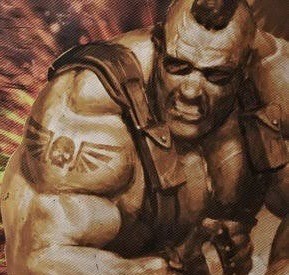
“Colonel Aldalon walked down the long chapel, past rows of Imperial Guard soldiers barracked inside. They looked up at him as he passed, hastily stiffening in respect for not only his rank but also the red bandanna he wore tied around his honestly ridiculously large bicep.
The Catachan Jungle Fighters were legendary among the Astra Militarum. In stories told to children they were almost as lauded as the Adeptus Astartes themselves, in a lot of ways maybe even more so, because the men and women of Catachan were just that – men and women. Everything they did, every storied battle they won, they did without all the advantages of the Emperor’s Space Marines.
Aldalon did not acknowledge the troopers around him in return. He had little time for soft-world Guardsmen, and these were worse than most…”
— The reputation of the Catachan Jungle Fighters. Excerpt From “Catachan Devil” by Justin Woolley.
#warhammer 40k#40k lore#40k#grimdark#wh40k#wh40k art#warhammer books#warhammer 40k lore#warhammer lore#warhammer 40000#40k art#catachan#catachan jungle fighters#games workshop#black library#imperial guard#warhammer imperial guard#astra militarum
7 notes
·
View notes
Link
Next Ep is up. Featuring Killgore the Malcador super heavy!
#warhammer 40k#warhammer#imperial guard#astra militarum#malcador#tank#super heavy tank#lore#background#my content#youtube#my minis#miniatures#tabletop gaming#wargames#grimdark
4 notes
·
View notes
Photo


After a bit of a run of successor chapters, we’re back to some First Founding lads. Also, tonight is the first night of Hanukkah, so it’s apropos that we get some boys strongly associated with fire. So for Day 18, we have the XVIII* Legion, the Salamanders!
Into the fires of battle, unto the anvil of war!
Vulkan lives!
The XVIII was with the VI Legion (the Space Wolves) in the triad of legions that were created by the Emperor in secret for Secret Purposes. When they went to battle, the XVIII distinguished themselves in battles where they won by the skin of their teeth against overwhelming odds, becoming known as the Dragon Warriors. Unlike other legions, they usually weren’t sent out to claim new worlds in the Emperor’s name, instead focusing on sudden threats in the Imperium’s heart. The Dragon Warriors quickly gained a reputation for extraordinary heroism, at the cost of regularly taking nasty casualties.
It was during one of these desperate last stands that the Primarch returned to the legion. Vulkan had landed on the volcanic planet of Nocturne, where he established himself as a mighty defender of his people and a blacksmith of great skill. When the Emperor came to his world, he and Vulkan competed in a number of challenges to see who was the greater hero; after a series of ties, the Emperor lost a challenge in order to save Vulkan’s life, at which point Vulkan knelt and agreed to serve the Emperor. After years of learning how to be general, Vulkan rode in with a bunch of new recruits just in time to save his sons from a truly ridiculous horde of Orks. When his sons went to kneel, he told them to rise, for all his sons were equals; then he knelt before them to honor their heroism.
Vulkan was a pretty cool dude. He renamed his legion the Salamanders, after the flame-resistant dragons of his homeworld.
Vulkan was also immortal--one of a weird tiny subset of people called Perpetuals, who’re incapable of dying no matter how much they might want to. This proved to be kind of a problem for him during the Heresy. His legion was one of the ones fucked up by a surprise attack at the start of the war, and the few remaining Salamanders would spend the rest of the war struggling to be relevant. Vulkan himself would be captured and tortured by one of his brothers, his immortality just giving him the chance for more suffering. It sucked.
After the Heresy, the Salamanders agreed to Guilliman’s plan to split everyone up into chapters. They didn’t have any successors in that first round of chapters, though, because there were so few Salamanders left that none could be scrounged up to split off. The Salamanders wouldn’t have any official successors until the arrival of Primaris marines, as their geneseed had a high rejection rate. Vulkan himself would just mysteriously vanish one day; chapter legends say that when nine artifacts he hid around the galaxy were gathered, he’d return to lead his chapter to lead his legion to glory.
The modern Salamanders are considered some of the most compassionate of Space Marines. They’re willing to sacrifice their lives for innocent people in a way that few other chapters are. This inherent nobility stands in sharp contrast to their appearance and methods of war. Their geneseed causes all Salamander recruits to develop coal-black skin and glowing red eyes (yes, this is fucked up on several levels), which a lot of people find real frightening. They also have a somewhat disturbing obsession with flame weaponry. They really like using flamethrowers, and burning swords, and have burning backpacks. Nothing says heroism like dousing your enemies in napalm, I guess. The last major factor of Salamanders culture is their interest in blacksmithing. All Salamanders receive training in building and maintaining their gear, and their specialized smiths are some of the best in the Space Marines. However scary they might be, though, if you’re an Imperial Guardsman**, you’re going to be pretty happy to see a Salamander joining the battle on your side; they’re going to take more pains than any other chapter to keep you alive.
Aesthetically, Salamanders lean into their two major aesthetic cues of “fire” and “dragons”. They often have flame designs painted onto their armor, and will adorn themselves with scaly pelts of their namesake salamanders. I’d be remiss, though, if I didn’t mention their classic Badab War pain scheme, which took the idea of a ‘Salamander’ very literally.

Aw yeah. That’s the good shit.
*18 is the most annoying number to list in Roman numerals under 20.
**Imperial Guardsman? Whazzat?
I’ve mentioned several times that Space Marine chapters are only allowed to have 1,000 members, which is barely large enough to be any kind of useful fighting force. This raises the obvious question, who does most of the fighting in the Imperium? And the answer to that is: Regular people. Lots and lots and lots of regular people.
Every planet maintains a planetary defense force (PDF), a local militia that acts as first responders to emergencies; how well equipped these PDFs are varies wildly from planet to planet, depending how how wealthy the local government is. Every planet is also expected to give a tithe of soldiers to the Imperium at large, to serve in the Imperium’s main standing army: The Astra Militarum, also known as the Imperial Guard. How many guardsmen are there? Literally uncountable--intake and casualties both run in the millions per day. Easily billions, constantly being deployed to new battlefronts across the galaxy.
The Imperial Guard mostly resembles a late World War II army in how it fights. The bulk of its forces consist of squads of people with semi-automatic rifles (lasguns, very accurate, but not very powerful on the silly scale of power used by 40k), supplemented by specialist weapons like flamethrowers and machine guns. They’re delivered by APCs, fight alongside tanks, and can call in air and artillery support; the Imperial Guard’s vehicle pool is actually quite impressive, somewhat outclassing that of the Space Marines.
Guardsmen are organized into regiments, and each one has its own flavor and specialties based on its homeworld. The ‘standard’ template is that of the Cadian Shock Troopers, who look like Starship Troopers guys. Other prominent examples include the Attilan Rough Riders (Hun-like cavalrymen), Catachan jungle fighters (an entire army of Rambo references from space Vietnam), the Death Korps of Krieg (WWI German soldiers in gas masks), Tallarn Desert Raiders (Arabic-themed desert cavalrymen), and the Vostroyan Firstborn (poncy Russian noblemen). Most of these don’t have models made by Games Workshop anymore, which means that third party sites to gangbusters business selling them themselves.
The Imperial Guard uses several specialist forces. A few planets have produced stable human subspecies called ‘abhumans’; they’re generally discriminated against in the Imperium, but they still get sent to war, because of course they are. Two major strains are Ogryns (big, strong, not very smart), and Ratlings (small, very skilled snipers). These serve as auxiliaries to the main Guard regiment. There are also the Tempestus Scion, elite troopers who get better armor, better gear, and better training, dropping into the places where fighting is hardest. They’re like budget Space Marines.
The last notable thing about the Imperial Guard worth mentioning is the morale officer, known as the ‘Commissar’. The commissar’s job is to maintain discipline in the unit, keeping them from fleeing the enemy. There’s actually a lot of ways to do this job, but the way most commonly seen in the game and most often joked about is by shooting a fleeing soldier in the head. In the Imperial Guard, the only thing scarier than the enemy in front of you is the commissar behind you.
Life in the Astra Militarum is usually nasty, brutish, and short. You’re underequipped, undertrained, and being sent up against horrors beyond human comprehension. Survival is not guaranteed. But you have your fellows at your side, and your faith to guide you. Stories about the Imperial Guard are some of the most emotionally effective in 40k, as they’re just normal people put in horrible circumstances, as often the victim of their own incompetent leadership as enemy forces. No supersoldier serums for these folks, just flak armor and faith.
They’re doomed.
#warhammer 40k#space marines#advent calendar#text heavy#lore dump#40k advent#salamanders#imperial guard#astra militarum
3 notes
·
View notes
Text
84th Sigman Kerberos when the Slaangors be Sussy Baka:
youtube
#tempestus scions#warhammer 40k#warhammer#84th Sigman Kerberos#astra militarum#Militarum Tempestus#meme#funny memes#40k memes#warhammer meme#homebrew#homebrew lore#Youtube
0 notes
Text
Why The Tau Were Never 'Too Good' For 40k

The Tau were added midway through Warhammer 40,000's 3rd edition, though according to some records the idea had been floating around since Laserburn. In the twenty years since their introduction to the 41st millennium, the Tau have remained one of the most consistently reviled and hated aspect of 40k lore, with all complaints around them boiling down to one core issue: they're too good for 40k.
By that, people mean that they are too morally good to fit within the grimdark narrative of the 41st millennium. This has always been the primary complaint levied at them, since they were first introduced in 2001. And GW has seemingly agreed with them, and spent the last 20 years trying to inject grimdarkness into the Tau Empire.
The first attempt to grimdarkify the Tau came very early on, with the Tau campaign in Dawn of War: Dark Crusade
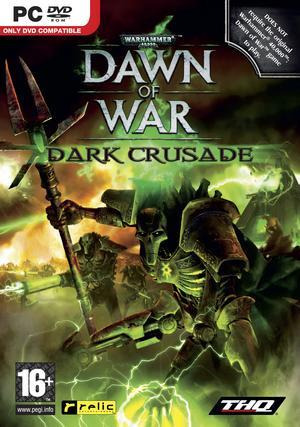
It's explained how in the decade following Tau victory on Kronus the remaining human population was subjugated, oppressed, forced to give up their culture, and eventually simply sterilized and allowed to die off naturally to create a Tau and Kroot ethnostate on Kronus. It explains this over images of prisoners of war being fed to Krootox in prison camps and humans huddling together in slums.
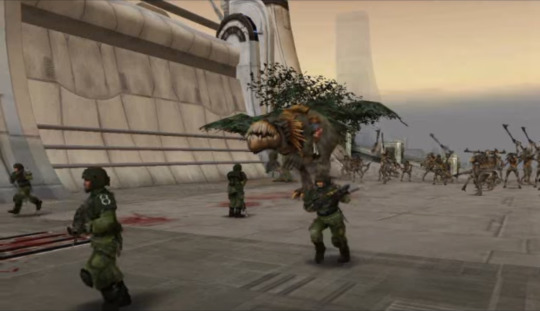

This is obviously a departure from the image of the Tau as it was established in Codex: Tau (3rd Edition), as that codex makes explicit mention of the Tau trading and making alliances with frontier human colonies. This is also a departure from... common sense. Why exactly would the Tau accept Kroot, Vespid, Nicassar, Demiurg, Tarellians and many others into their ranks but then arbitrarily draw the line at humans?
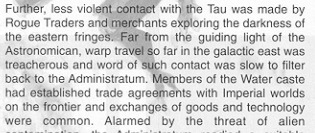
This would become a pattern that I like to call "The Grimderp Tau Cycle." It's not exactly a stretch to say that the Tau are easily the most morally good society in the 41st millennium. Their tolerance toward other species alone makes them head and shoulders above almost any other species in the galaxy. So to remind people that there are no good guys in the 41st millennium and that this is a very serious and grimdark setting that you need to take seriously because there are no good guys or whatever, GW will occasionally have the Tau commit a completely out of character, random, and nonsensical atrocity. This was also seen at the end of In Harmony Restored, the short story that came out alongside 8th edition's Psychic Awakening: The Greater Good.

For context, In Harmony Restored is a short story about a group of Gue'vesa soldiers (human auxiliary troops fighting in the Tau military) performing a desperate defensive rearguard action to halt an Imperial advance long enough for Tau reinforcements to come and smash the delayed invasion force. The Gue'vesa are able to do this, though at great sacrifice to themselves, and then when the reinforcing army does arrive and makes quick work of the Imperial army they then continue on to butcher the Gue'vesa soldiers who performed this valiant holding action for... Seemingly no reason? Assuming the Tau forces thought they were more Astra Militarum soldiers, the Gue'vesa step out of cover pleading for mercy, only to be gunned down. With one of the Gue'vesa at the end noting that the language one of the Battlesuit pilots is using is very reminiscent of the way the Imperium talks about those they've labeled undesirables.
The message here is clear: these humans betrayed the Imperium in order to escape from the Imperium's genocidal regime... Only to end up in the equally merciless clutches of an equally ruthless oppressor. But, from a lore standpoint, that defeats the entire purpose of the Tau. It makes them wholly indistinct and, frankly, boring. But that doesn't even scratch the surface of how stupid this is, because it has clearly been stated in the past that the Tau do not hold bigotries toward client species on the basis of their faiths. And that makes sense.
Not only does this contradict previous lore, not only does it render the Tau a boring palette swapped version of the Imperium, it also just defies practical sense. If you're a race like the Tau, who expand primarily through ingratiating yourself with other races and convincing them to join your collective, you'd naturally want as few barriers between potential client races and joining as possible. No human colony is going to voluntarily join the Greater Good if the Tau's version of the Greater Good happens to require that the human population of that planet lose all sense of their heritage and culture through forced reeducation and the abandonment of their faith, and in the long term for that human population to slowly go extinct through gradual forced sterilization and confinement to ghettos and slums.
It's deeply stupid, lazy writing on the part of GW to repair the image of the Tau in the eyes of a fandom who accused the faction of being "too good." Except, uhm, here's the thing: the Tau were never too good to begin with. Lets rewind back to 3rd Edition's Tau Codex, our first introduction to the Tau in the 40k universe. From the very beginning it was very clear that the Utopian idealism of the Tau Empire held beneath the surface a significantly more sinister and malevolent nature, and it all roots from the mysterious and enigmatic fifth caste of Tau Society: the Ethereals.

In 3rd Edition, the Ethereals are spoken of more like mythological beings than the slightly mundane way they exist in modern 40k. All we know about them out of this book is that they are the autocratic leaders of the Tau Empire who inspire radical devotion among the Tau, though are rarely seen or heard from. They reorganized Tau society with pursuit of the Greater Good in mind first. But the specifics of what that means matters a lot. Tau are born into a caste that roughly determines, from birth, what role in society that person will fulfill. Those born into a caste are not allowed to have children with members of other castes, are not allowed to take up any job or position that contradicts the societal purpose of their caste, and generally lack self-determination in regards to things like career choice.
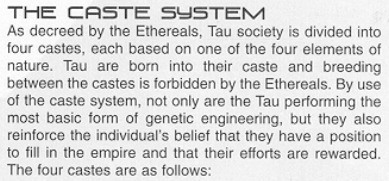
so, bam, the setup for Tau as a flawed and morally ambiguous faction are already present. They're a faction who fight for a better future, for a galaxy where all can exist in harmony with one another, so long as that harmony is kosher by the standards of the Ethereal caste. In that sense they're somewhat similar to the Dominion from Star Trek: Deep Space Nine. A multispecies interstellar collective who seek to create a galaxy harmoniously unified... in service to the Founders. Just taken from this vision of the Tau Empire, they're already an autocratic dictatorship who fight in the name of an ideology that declares itself to be for the greater good of all who ascribe to it while also relying on the assumption that the tyrannical power of the Ethereals must inherently be for the Greater Good. I reject the idea that the Tau were ever "too good" for 40k. Rather that they were written with a realistic level of nuance, with an understanding that dictatorships are built upon cognitive dissonance, not on perfectly consistent virtues.
TL;DR
THEY'RE NOT FUCKING COMMUNISTS, THEY LITERALLY HAVE A CASTE SYSTEM, WHAT THE FUCK ARE YOU TALKING ABOUT?!
#warhammer40k#warhammer#warhammer 40k#t'au empire#t'au#fire warrior#in this essay i will#wargaming#warhammer lore
369 notes
·
View notes
Text
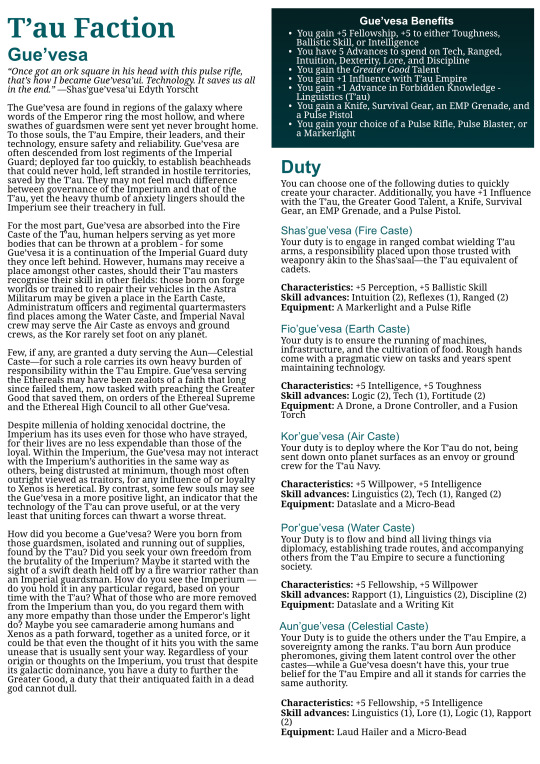
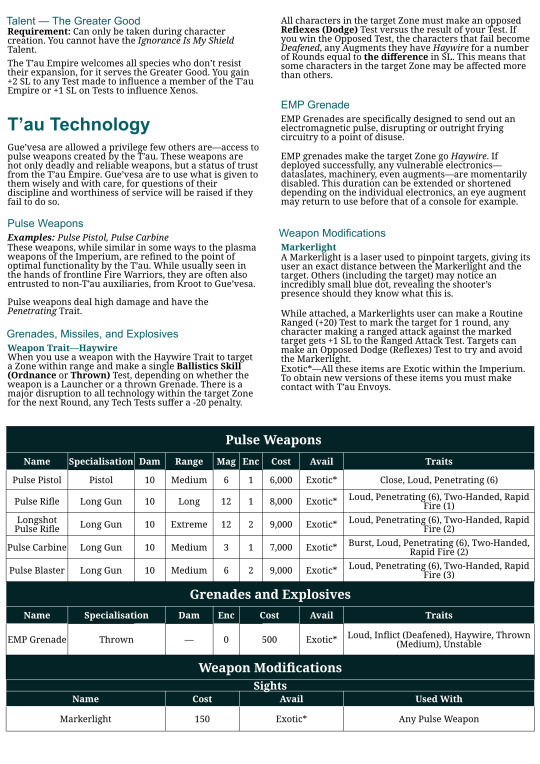
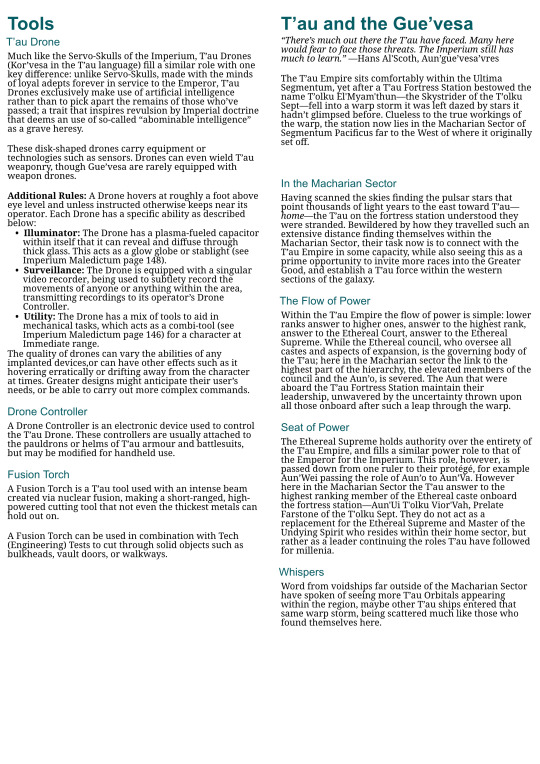

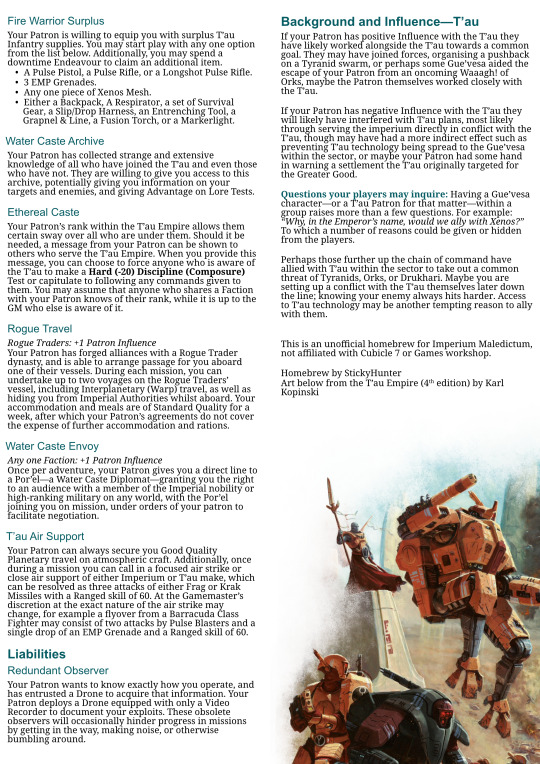
Gue'vesa and the T'au Empire—rules for Imperium Maledictum
Want to play a human under the T'au or have a T'au Patron for that matter? Well hey I've got you covered!
Plain text version under the cut
T’au Faction
Gue’vesa
“Once got an ork square in his head with this pulse rifle, that’s how I became Gue’vesa’ui. Technology. It saves us all in the end.” —Shas’gue’vesa’ui Edyth Yorscht
The Gue’vesa are found in regions of the galaxy where words of the Emperor ring the most hollow, and where swathes of guardsmen were sent yet never brought home. To those souls, the T’au Empire, their leaders, and their technology, ensure safety and reliability. Gue’vesa are often descended from lost regiments of the Imperial Guard; deployed far too quickly, to establish beachheads that could never hold, left stranded in hostile territories, saved by the T’au. They may not feel much difference between governance of the Imperium and that of the T’au, yet the heavy thumb of anxiety lingers should the Imperium see their treachery in full.
For the most part, Gue’vesa are absorbed into the Fire Caste of the T’au, human helpers serving as yet more bodies that can be thrown at a problem - for some Gue’vesa it is a continuation of the Imperial Guard duty they once left behind. However, humans may receive a place amongst other castes, should their T’au masters recognise their skill in other fields: those born on forge worlds or trained to repair their vehicles in the Astra Militarum may be given a place in the Earth Caste, Administratum officers and regimental quartermasters find places among the Water Caste, and Imperial Naval crew may serve the Air Caste as envoys and ground crews, as the Kor rarely set foot on any planet.
Few, if any, are granted a duty serving the Aun—Celestial Caste—for such a role carries its own heavy burden of responsibility within the T’au Empire. Gue’vesa serving the Ethereals may have been zealots of a faith that long since failed them, now tasked with preaching the Greater Good that saved them, on orders of the Ethereal Supreme and the Ethereal High Council to all other Gue’vesa.
Despite millenia of holding xenocidal doctrine, the Imperium has its uses even for those who have strayed, for their lives are no less expendable than those of the loyal. Within the Imperium, the Gue’vesa may not interact with the Imperium’s authorities in the same way as others, being distrusted at minimum, though most often outright viewed as traitors, for any influence of or loyalty to Xenos is heretical. By contrast, some few souls may see the Gue’vesa in a more positive light, an indicator that the technology of the T’au can prove useful, or at the very least that uniting forces can thwart a worse threat.
How did you become a Gue’vesa? Were you born from those guardsmen, isolated and running out of supplies, found by the T’au? Did you seek your own freedom from the brutality of the Imperium? Maybe it started with the sight of a swift death held off by a fire warrior rather than an Imperial guardsman. How do you see the Imperium — do you hold it in any particular regard, based on your time with the T’au? What of those who are more removed from the Imperium than you, do you regard them with any more empathy than those under the Emperor's light do? Maybe you see camaraderie among humans and Xenos as a path forward, together as a united force, or it could be that even the thought of it hits you with the same unease that is usually sent your way. Regardless of your origin or thoughts on the Imperium, you trust that despite its galactic dominance, you have a duty to further the Greater Good, a duty that their antiquated faith in a dead god cannot dull.
Gue’vesa Benefits
You gain +5 Fellowship, +5 to either Toughness, Ballistic Skill, or Intelligence
You have 5 Advances to spend on Tech, Ranged, Intuition, Dexterity, Lore, and Discipline.
You gain the Greater Good Talent.
You gain +1 Influence with T’au Empire
You gain +1 Advance in Forbidden Knowledge - Linguistics (T’au)
You gain a Knife, Survival Gear, an EMP Grenade, and a Pulse Pistol
You gain your choice of a Pulse Rifle, Pulse Blaster, or a Markerlight
Duty
You can choose one of the following duties to quickly create your character. Additionally, you have +1 Influence with the T’au, the Greater Good Talent, a Knife, Survival Gear, an EMP Grenade, and a Pulse Pistol.
Shas’gue’vesa (Fire Caste)
Your duty is to engage in ranged combat wielding T’au arms, a responsibility placed upon those trusted with weaponry akin to the Shas’saal—the T’au equivalent of cadets.
Characteristics: +5 Perception, +5 Ballistic Skill
Skill advances: Intuition (2), Reflexes (1), Ranged (2)
Equipment: A Markerlight and a Pulse Rifle
Fio’gue’vesa (Earth Caste)
Your duty is to ensure the running of machines, infrastructure, and the cultivation of food. Rough hands come with a pragmatic view on tasks and years spent maintaining technology.
Characteristics: +5 Intelligence, +5 Toughness
Skill advances: Logic (2), Tech (1), Fortitude (2)
Equipment: A Drone, a Drone Controller, and a Fusion Torch
Kor’gue’vesa (Air Caste)
Your duty is to deploy where the Kor T’au do not, being sent down onto planet surfaces as an envoy or ground crew for the T’au Navy.
Characteristics: +5 Willpower, +5 Intelligence
Skill advances: Linguistics (2), Tech (1), Ranged (2)
Equipment: Dataslate and a Micro-Bead
Por’gue’vesa (Water Caste)
Your Duty is to flow and bind all living things via diplomacy, establishing trade routes, and accompanying others from the T’au Empire to secure a functioning society.
Characteristics: +5 Fellowship, +5 Willpower
Skill advances: Rapport (1), Linguistics (2), Discipline (2)
Equipment: Dataslate and a Writing Kit
Aun’gue’vesa (Celestial Caste)
Your Duty is to guide the others under the T’au Empire, a sovereignty among the ranks. T’au born Aun produce pheromones, giving them latent control over the other castes—while a Gue’vesa doesn’t have this, your true belief for the T’au Empire and all it stands for carries the same authority.
Characteristics: +5 Fellowship, +5 Intelligence
Skill advances: Linguistics (1), Lore (1), Logic (1), Rapport (2)
Equipment: Laud Hailer and a Micro-Bead
Talent — The Greater Good
Requirement: Can only be taken during character creation. You cannot have the Ignorance Is My Shield Talent.
The T’au Empire welcomes all species who don’t resist their expansion, for it serves the Greater Good. You gain +2 SL to any Test made to influence a member of the T’au Empire or +1 SL on Tests to influence Xenos.
T’au Technology
Gue’vesa are allowed a privilege few others are—access to pulse weapons created by the T’au. These weapons are not only deadly and reliable weapons, but a status of trust from the T’au Empire. Gue’vesa are to use what is given to them wisely and with care, for questions of their discipline and worthiness of service will be raised if they fail to do so.
Pulse Weapons
Examples: Pulse Pistol, Pulse Carbine
These weapons, while similar in some ways to the plasma weapons of the Imperium, are refined to the point of optimal functionality by the T’au. While usually seen in the hands of frontline Fire Warriors, they are often also entrusted to non-T’au auxiliaries, from Kroot to Gue’vesa.
Pulse weapons deal high damage and have the Penetrating Trait.

Grenades, Missiles, and Explosives
Weapon Trait—Haywire
When you use a weapon with the Haywire Trait to target a Zone within range and make a single Ballistics Skill (Ordnance or Thrown) Test, depending on whether the weapon is a Launcher or a thrown Grenade. There is a major disruption to all technology within the target Zone for the next Round, any Tech Tests suffer a -20 penalty.
All characters in the target Zone must make an opposed Reflexes (Dodge) Test versus the result of your Test. If you win the Opposed Test, the characters that fail become Deafened, any Augments they have Haywire for a number of Rounds equal to the difference in SL. This means that some characters in the target Zone may be affected more than others.
EMP Grenade
EMP Grenades are specifically designed to send out an electromagnetic pulse, disrupting or outright frying circuitry to a point of disuse.
EMP grenades make the target Zone go Haywire. If deployed successfully, any vulnerable electronics—dataslates, machinery, even augments—are momentarily disabled. This duration can be extended or shortened depending on the individual electronics, an eye augment may return to use before that of a console for example.

Weapon Modifications
Markerlight
A Markerlight is a laser used to pinpoint targets, giving its user an exact distance between the Markerlight and the target. Others (including the target) may notice an incredibly small blue dot, revealing the shooter’s presence should they know what this is.
While attached, a Markerlights user can make a Routine Ranged (+20) Test to mark the target for 1 round, any character making a ranged attack against the marked target gets +1 SL to the Ranged Attack Test. Targets can make an Opposed Dodge (Reflexes) Test to try and avoid the Markerlight.

Exotic*—All these items are Exotic within the Imperium. To obtain new versions of these items you must make contact with T’au Envoys.
Tools
T’au Drone
Much like the Servo-Skulls of the Imperium, T’au Drones (Kor’vesa in the T’au language) fill a similar role with one key difference: unlike Servo-Skulls, made with the minds of loyal adepts forever in service to the Emperor, T’au Drones exclusively make use of artificial intelligence rather than to pick apart the remains of those who’ve passed; a trait that inspires revulsion by Imperial doctrine that deems an use of so-called “abominable intelligence” as a grave heresy.
These disk-shaped drones carry equipment or technologies such as sensors. Drones can even wield T’au weaponry, though Gue’vesa are rarely equipped with weapon drones.
Additional Rules: A Drone hovers at roughly a foot above eye level and unless instructed otherwise keeps near its operator. Each Drone has a specific ability as described below:
Illuminator: The Drone has a plasma-fueled capacitor within itself that it can reveal and diffuse through thick glass. This acts as a glow globe or stablight (see Imperium Maledictum page 148).
Surveillance: The Drone is equipped with a singular video recorder, being used to subtlety record the movements of anyone or anything within the area, transmitting recordings to its operator’s Drone Controller.
Utility: The Drone has a mix of tools to aid in mechanical tasks, which acts as a combi-tool (see Imperium Maledictum page 146) for a character at Immediate range.
The quality of drones can vary the abilities of any implanted devices,or can have other effects such as it hovering erratically or drifting away from the character at times. Greater designs might anticipate their user’s needs, or be able to carry out more complex commands.
Drone Controller
A Drone Controller is an electronic device used to control the T’au Drone. These controllers are usually attached to the pauldrons or helms of T’au armour and battlesuits, but may be modified for handheld use.
Fusion Torch
A Fusion Torch is a T’au tool used with an intense beam created via nuclear fusion, making a short-ranged, high-powered cutting tool that not even the thickest metals can hold out on.
A Fusion Torch can be used in combination with Tech (Engineering) Tests to cut through solid objects such as bulkheads, vault doors, or walkways.
T’au and the Gue’vesa
“There’s much out there the T’au have faced. Many here would fear to face those threats. The Imperium still has much to learn.” —Hans Al'Scoth, Aun’gue’vesa’vres
The T’au Empire sits comfortably within the Ultima Segmentum, yet after a T’au Fortress Station bestowed the name T’olku El'Myam'thun—the Skystrider of the T’olku Sept—fell into a warp storm it was left dazed by stars it hadn’t glimpsed before. Clueless to the true workings of the warp, the station now lies in the Macharian Sector of Segmentum Pacificus far to the West of where it originally set off.
In the Macharian Sector
Having scanned the skies finding the pulsar stars that point thousands of light years to the east toward T’au—home—the T’au on the fortress station understood they were stranded. Bewildered by how they travelled such an extensive distance finding themselves within the Macharian Sector, their task now is to connect with the T’au Empire in some capacity, while also seeing this as a prime opportunity to invite more races into the Greater Good, and establish a T’au force within the western sections of the galaxy.
The Flow of Power
Within the T’au Empire the flow of power is simple: lower ranks answer to higher ones, answer to the highest rank, answer to the Ethereal Court, answer to the Ethereal Supreme. While the Ethereal council, who oversee all castes and aspects of expansion, is the governing body of the T’au; here in the Macharian sector the link to the highest part of the hierarchy, the elevated members of the council and the Aun’o, is severed. The Aun that were aboard the T’au Fortress Station maintain their leadership, unwavered by the uncertainty thrown upon all those onboard after such a leap through the warp.
Seat of Power
The Ethereal Supreme holds authority over the entirety of the T’au Empire, and fills a similar power role to that of the Emperor for the Imperium. This role, however, is passed down from one ruler to their protégé, for example Aun’Wei passing the role of Aun’o to Aun’Va. However here in the Macharian Sector the T’au answer to the highest ranking member of the Ethereal caste onboard the fortress station—Aun'Ui T'olku Vior'Vah, Prelate Farstone of the T'olku Sept. They do not act as a replacement for the Ethereal Supreme and Master of the Undying Spirit who resides within their home sector, but rather as a leader continuing the roles T’au have followed for millenia.
Whispers
Word from voidships far outside of the Macharian Sector have spoken of seeing more T’au Orbitals appearing within the region, maybe other T’au ships entered that same warp storm, being scattered much like those who found themselves here.
Patrons
As a Gue’vesa, your Patron is likely a servant of the T’au Empire, or, in a rare show of fragile trust between the T’au Empire and Imperium, you serve an Imperial Patron.
T’au Patron
Your Patron is a member of the T’au Empire, seizing their chance in this new territory to establish a beachhead and secure alliances. Unknown to the everyday citizen of the Imperium, the T’au would appear to be just another Xenos threat, yet your Patron hopes with a helpful hand that Imperial systems will slowly come to see the higher truth of the Greater Good. The looming presence of the Imperium is ever in your Patron’s mind, forcing them into political engagements that are beyond complex.
Influence: Your Patron has +2 Influence with the T’au Empire.
Duty: Your Patron is either a Shas’o—A Fire Commander—or a Aun’saal—an Ethereal Lord.
Shas’o (Fire Commander)
Your Patron holds the highest rank within the T’au army, similar to that of a Commander. While many within the fire caste see this as the only way of leaving the T’au military aside from death, others seize it as an opportunity for control. Your Patron not only understands warfare, but has seen it up-close at a scale like few in the Fire Caste let alone the T'au Empire have been unfortunate enough to witness.
Free Boon: T’au Firepower
Your Patron is able to procure T’au weaponry with little interruption. You have Advantage on Availability Tests for T’au technology, T’au technology becomes 2 steps easier to obtain.
Aun’saal (Ethereal Lord)
Your Patron is a high-ranking T’au, a lord in their own right, and not one to mince words. Their word is law, and those words can prove inspirational. Your Patron is studious, knowing words can cut like a sword; and that negotiation is just as powerful as any gun.
Free Boon: Ethereal Caste
Your Patron’s rank within the T’au Empire allows them certain sway over all who are under them. Should it be needed, a message from your Patron can be shown to others who serve the T’au Empire. When you provide this message, you can choose to force anyone who is aware of the T’au to make a Hard (-20) Discipline (Composure) Test or capitulate to following any commands given to them. You may assume that anyone who shares a Faction with your Patron knows of their rank, while it is up to the GM who else is aware of it.


Anything marked with an * is listed below, all others listed are found within the Imperium Maledictum Core Book.
Boons
Auxilarist
Your Patron can call on a small squad of Kroot Mercenaries that can be found within the Macharian Sector. Once per mission, your Patron can put a number of Kroot Mercenaries (page 349) equal to the number of characters in the party under the party’s command for a day. The Kroot Mercenaries are under the control of the Gamemaster, and have been instructed to aid the party.
T’au Firepower
Your Patron is able to procure T’au weaponry with little interruption. You have Advantage on Availability Tests, T’au technology becomes 2 steps easier to obtain.
Fire Warrior Surplus
Your Patron is willing to equip you with surplus T’au Infantry supplies. You may start play with any one option from the list below. Additionally, you may spend a downtime Endeavour to claim an additional item.
A Pulse Pistol, a Pulse Rifle, or a Longshot Pulse Rifle.
3 EMP Grenades.
Any one piece of Xenos Mesh.
Either a Backpack, A Respirator, a set of Survival Gear, a Slip/Drop Harness, an Entrenching Tool, a Grapnel & Line, a Fusion Torch, or a Markerlight.
Water Caste Archive
Your Patron has collected strange and extensive knowledge of all who have joined the T’au and even those who have not. They are willing to give you access to this archive, potentially giving you information on your targets and enemies, and giving Advantage on Lore Tests.
Ethereal Caste
Your Patron’s rank within the T’au Empire allows them certain sway over all who are under them. Should it be needed, a message from your Patron can be shown to others who serve the T’au Empire. When you provide this message, you can choose to force anyone who is aware of the T’au to make a Hard (-20) Discipline (Composure) Test or capitulate to following any commands given to them. You may assume that anyone who shares a Faction with your Patron knows of their rank, while it is up to the GM who else is aware of it.
Rogue Travel
Rogue Traders: +1 Patron Influence
Your Patron has forged alliances with a Rogue Trader dynasty, and is able to arrange passage for you aboard one of their vessels. During each mission, you can undertake up to two voyages on the Rogue Traders’ vessel, including Interplanetary (Warp) travel, as well as hiding you from Imperial Authorities whilst aboard. Your accommodation and meals are of Standard Quality for a week, after which your Patron’s agreements do not cover the expense of further accommodation and rations.
Water Caste Envoy
Any one Faction: +1 Patron Influence
Once per adventure, your Patron gives you a direct line to a Por’el—a Water Caste Diplomat—granting you the right to an audience with a member of the Imperial nobility or high-ranking military on any world, with the Por’el joining you on mission, under orders of your patron to facilitate negotiation.
T’au Air Support
Your Patron can always secure you Good Quality Planetary travel on atmospheric craft. Additionally, once during a mission you can call in a focused air strike or close air support of either Imperium or T’au make, which can be resolved as three attacks of either Frag or Krak Missiles with a Ranged skill of 60. At the Gamemaster’s discretion at the exact nature of the air strike may change, for example a flyover from a Barracuda Class Fighter may consist of two attacks by Pulse Blasters and a single drop of an EMP Grenade and a Ranged skill of 60.
Liabilities
Redundant Observer
Your Patron wants to know exactly how you operate, and has entrusted a Drone to acquire that information. Your Patron deploys a Drone equipped with only a Video Recorder to document your exploits. These obsolete observers will occasionally hinder progress in missions by getting in the way, making noise, or otherwise bumbling around.
Background and Influence—T’au
If your Patron has positive Influence with the T’au they have likely worked alongside the T’au towards a common goal. They may have joined forces, organising a pushback on a Tyranid swarm, or perhaps some Gue’vesa aided the escape of your Patron from an oncoming Waaagh! of Orks, maybe the Patron themselves worked closely with the T’au.
If your Patron has negative Influence with the T’au they will likely have interfered with T’au plans, most likely through serving the imperium directly in conflict with the T’au, though may have had a more indirect effect such as preventing T’au technology being spread to the Gue’vesa within the sector, or maybe your Patron had some hand in warning a settlement the T’au originally targeted for the Greater Good.
Questions your players may inquire: Having a Gue’vesa character—or a T’au Patron for that matter—within a group raises more than a few questions. For example: “Why, in the Emperor’s name, would we ally with Xenos?” To which a number of reasons could be given or hidden from the players. Perhaps those further up the chain of command have allied with T’au within the sector to take out a common threat of Tyranids, Orks, or Drukhari. Maybe you are setting up a conflict with the T’au themselves later down the line; knowing your enemy always hits harder. Access to T’au technology may be another tempting reason to ally with them.
#imperium maledictum#warhammer 40k#warhammer 40000#warhammer 40k roleplay#t'au#t'au empire#gue'vesa#guevesa#homebrew#hey i made a thing! I really wanted to practice writing something that wasn't 5e so chose a *chef kiss* system
54 notes
·
View notes
Text

Alternative title: Mädels und Bier
Sergeant Rokken "Rokk" Tamaguchi, previously seen in "Once a Cadian, Always a Cadian" makes an encore appearance.
Excerpt
‘Well, boys. Is there anything you’d really like to have, but you can’t get it in the Imperium? Something you really, really want, but the Astra Militarum just won’t let you have it?’
There was a bit of shuffling around, and someone sneezed.
‘1158, I think we’re getting somewhere!’ said Tamaguchi, glancing over his shoulder. Catching the eye of the first grenadier, he asked, ‘How about you Walter?’
Walter looked at the ground, and said softly, ‘Mädels und Bier.’
‘What was that?’ he asked, putting a hand to his ear.
‘Mädels und Bier,’ he said louder.
‘Girls and beer?’Tamaguchi rubbed his nose. ‘You want girls and beer? Hell yes, we got girls and beer!’
#Mädels und Bier#Girls and Beer#wh40k lore fiction#imperial guard#death korp of kreig#astra militarum#what does a krieger really really want?#come to the greater good#we got puppies#we got kitties#we got rabbits#n.y.a.b.x.t.t.
1 note
·
View note
Note
ok asking you some cursed shit

THis tank has 4 MGs on the top, one hull mounted siege mortar and two lascannons on the side sponsors (so think of them as like idk 40mm AT cannons on the side.) what do you think mr Tank? DOes this ww1 looking ass tank have a chance at being usefull irl?
Malcador Defender, Astra Militarum Assault Tank, Forge World Voss, ~M29.743
MALCADOR TANK MENTIONED
MALCADOR TANK MENTIONED
In case you didn't pick it up, I love this stupid, infeasible tank. It's like a mashup of several different ww2 designs, mixed with the wrap-around tread on the on the British landships of ww1.
It's got the massive, front-mounted stubby gun as seen on the Petard or Sturmtiger, and the lascannon placement in the sponsons is quite reminiscent of the British Mark V.
In lore, the Defender was designed as a mobile fortress, and while in real life, I hate vehicles like that, (looking at you, you Ratte bastard) here, I don't mind it so much, since it's warhammer and everything is a dumb stupid British army men game.
All in all, it's a batshit design, would be absolutely terrible in real life, for most of the same reasons it's terrible in lore. No engine can support something that heavy, and a fixed turret with a narrow angle of fire is a recipe to get you killed, as the Testudo T-72 in Ukraine can attest. Additionally, there's a reason we abandoned wrap-around tracks.
(However, this does not stop me from wanting one for my ww1 french-themed DKOK army.)
16 notes
·
View notes
Text

Welcome to the fantastic world of the Astra 'Santa' Militarum!
Let me tell you a bit more about myself; I'm somewhat of a novice in the vast Warhammer 40K universe. I heard about the franchise's name during my high school years when passing by a 'Games Workshop' store while buying my D&D dice and books. At that time, Warhammer seemed like an impenetrable fortress, especially for a girl, and the cost was very high. I didn't suspect the richness of the lore and narratives it held.
Fast forward about fifteen years to my encounter with the man who became my husband, a hobbyist in modeling and painting miniature figurines, including those of 40K. His passion for the lore and the way he talked about it triggered my curiosity, sparking my ADHD into high gear.
As he rekindled his interest in Warhammer and resumed collecting figurines after a 15-year hiatus, I was drawn to the Adepta Sororitas, particularly their saint, Celestine. This admiration led to my own detachment of the Adepta Sororitas, patiently waiting for me to free up some time to paint it.
Now, let's delve into the genesis of this specific artwork. One day, during a conversation with my husband about his Astra Militarum's tank division, the initial idea of an entire battalion of Christmas-decorated tanks emerged (unfortunately, I don't recall the exact conversation.) This whimsical idea lingered in my 'To Draw List' until now, waiting for the right moment to come to life. And here it finally is: a Leman Russ tank adorned with festive lights, steered by an officer dressed in a Santa uniform, a joyful fusion between Warhammer warfare and holiday magic!
Behold the Astra 'Santa' Militarum! In the dark and distant future reality, even the mighty Leman Russ tank joins the festive frenzy. Decked out with twinkling Christmas lights and steered by an officer clad in a Santa uniform, this festive spectacle brings a cheerful touch to the battlefield. Every bolt meticulously inked and painted, this tank is armed not only with firepower but also with a joyful merriment.
Software used: Clip Studio Paint.
#isilrinart#40k fanart#warhammer 40k#science fantasy#christmas spirit#astra militarum#leman russ#christmas edition#leman russ tank#christmas lights#hollyday spirit#40k#warhammer 40K fanart#vehicule#drawing minis#santa claus#santa clothes
10 notes
·
View notes
Note
I'm a slut for some 40k lore, tell me about the funny gas mask men with the shovles
Ah yes, the Death Korps of Krieg.
Krieg is a toxic, radioactive Death World within the Imperium of Man, and it is the homeworld of the Astra Militarum's Militarum Regimentum known as the Death Korps of Krieg.
Known for their common deployment in the war zones of the Segmentum Tempestus and Segmentum Solar, the Death Korps are particularly skilled at attritional trench warfare, sieges of and assaults upon heavily fortified static positions and warfare in extreme environments known for their biological, chemical and radioactive hazards.
Why are they like this? It's simple, nuclear armageddon.
Krieg was the site of a rebellion against the Imperium over 1500 years ago, in response to the rebellion the Loyalists bombarded the surface of the world with nuclear weapons, which was then followed by 500 years of grinding trench and tunnel based warfare between the Loyalists and Traitors.
After those centuries of nuclear destruction and tunnel warfare, Krieg was reduced to a radioactive husk, and its people were forced to live Metro 2033 style in underground hive cities to survive the toxic environment.
This forged them the people of Krieg into grim, fatalistic and dour individuals, and the soldiers of the Death Korps are even more so, they selflessly wade into the most abhorrent war zones satuarated with radiation and other toxins.
The military engagement they're involved are often decades long sieges with astronomically high casualty rates, and only those of Catachan stock are comparable to the men and women of Krieg.
Almost all Imperial Guardsmen from Krieg, save vehicle crews, wear their distinctive and highly advanced respirator units that filter out toxic and radioactive particles.
These gasmasks are a relic of their world, and act as a legacy and reminder of Krieg's eternal service to the needs of the Imperium.
Oh yes, and I forgot to mention, the nuclear armageddon was not a one off thing, the Loyalists didn't just fire the nukes once, they had kept firing nukes for the 500 years they were fighting the Traitors.
Now I don't need to tell you this as it is fairly obvious, the Death Korps of Krieg are modeled after WWI German soldiers, the trench warfare of WWI, while their name means War in German.
The helmet top shares a profile with the French Adrian helmet while the bottom part is clearly inspired by the German Stalhelm.
The iconic gasmask is extremely similar to the British SBR gasmask used during the war.
The bayonet is modeled after the American M1917 Bayonet.
The Lasgun Model 98 is named after the German Gewehr 98.
The breastplate worn by Krieg Officers and Death Riders is inspired by the French Cuirassier breastplate.
The Krieg soldiers retreat when an objective proves too much, is a waste of men and materiel or is a tactical decision to ensure victory.
While this all make sense, have you actually heard of them running in fear? Became they have, on page 72 of Imperial Armor Volume 5, the 158th Regiment of the 12th Line Korps routed due to heavy heretic resistance on the second Vraksian defense line.
They retreated and even fragged their own commissars who tried to stop the retreat.
Aside from that, there are multiple instances of Krieg engineers screaming in fear as they faced Khornate Beserkers, proving that they are not unfeeling soldiers bred for war, their grim outlook is a byproduct of their environment, they aren't soldier who will march endlessly to their deaths, it just takes longer for them to break in comparison to other Imperial Guard units.
That said, I think it's important to consider that the Siege of Vraks, fall of Orpheus, and Dead Men Walking portrayals of Krieg all vary considerably, as each is an interpretation by a different author.
It is hard to picture the automatons of Dead Men Walking or the other short stories by Steve Lyons acting in the same manner as the Krieg soldiers in the routs described in Siege of Vraks.
Outside of those sources there are also occasional examples of Krieg soldiers who are pretty much indistinguishable from cadians in gasmasks.
Unfortunately Krieg soldiers caving in heretic skulls with their entrenching tool is a meme the community came up with and is not canon.

25 notes
·
View notes